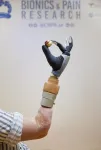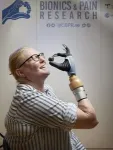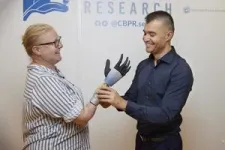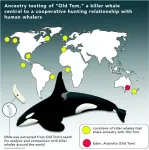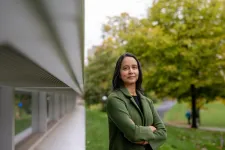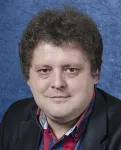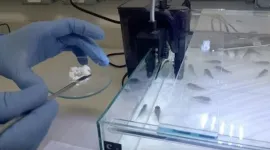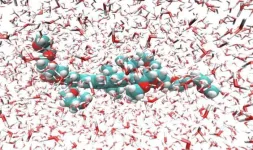(Press-News.org) Karin's life took a dramatic turn when a farming accident claimed her right arm over 20 years ago. Since then, she endured excruciating phantom limb pain. “It felt like I constantly had my hand in a meat grinder, which created a high level of stress and I had to take high doses of various painkillers.” In addition to her intractable pain, she found that conventional prostheses were uncomfortable and unreliable, and thus of little help in daily life. All this changed when she received groundbreaking bionic technology that allowed her to wear a much more functional prosthesis comfortably all day. The higher integration of between the bionic and Karin’s residual limb, also relieved her pain. “For me, this research has meant a lot, as it has given me a better life”.
A Remarkable Fusion of Human and Machine
Mechanical attachment and reliable control of prosthetic limbs are two of the biggest challenges in artificial limb replacement. People with limb loss often reject even the sophisticated prostheses commercially available because of these reasons, meaning painful and uncomfortable attachment with limited and unreliable controllability. A multidisciplinary group of engineers and surgeons solved these problems by developing a human-machine interface that allows for the prosthesis to be comfortably attached to the user’s skeleton via osseointegration, while also enabling electrical connection with the nervous system via electrodes implanted in nerves and muscles (video at https://youtu.be/YRxtM0Y6ZAQ).
The research was led by Prof. Max Ortiz Catalan, head of neural prosthetics research at the Bionics Institute in Australia and founder of the Center for Bionics and Pain Research (CBPR) in Sweden. “Karin was the first person with below-elbow amputation who received this new concept of a highly integrated bionic hand that can be used independently and reliably in daily life. The fact that she has been able to use her prosthesis comfortably and effectively in daily activities for years is a promising testament to the potential life-changing capabilities of this novel technology for individuals facing limb loss”. The challenges at this level of amputation are the two bones (radius and ulna) that should be aligned and loaded equally, and that not much space is available for implanted and prosthetic components. The research team nevertheless managed to develop a suitable neuromusculoskeletal implant that allows for connecting the user’s biological control system (the nervous system) with the electronic control system of the prosthesis. “Our integrated surgical and engineering approach also explains the reduction in pain, as Karin is now using somewhat the same neural resources to control the prosthesis as she did for her missing biological hand”. Treatment and prevention of post-amputation pain is another major goal for Prof. Ortiz Catalan’s team. Regarding this matter, Karin said to now have “better control over my prosthesis, but above all, my pain has decreased. Today, I need much less medication”.
A key feature of the new bionic technology is the skeletal attachment of the prosthesis via osseointegration; the process by which bone tissue embraces titanium creating a strong mechanical connection. Prof. Rickard Brånemark, research affiliate at MIT, associate professor at Gothenburg University, and CEO of Integrum, led the surgery and has worked with osseointegration for limb prosthesis since they were first used in humans: “The biological integration of titanium implants into bone tissue creates opportunities to further advance amputee care. By combining osseointegration with reconstructive surgery, implanted electrodes, and AI, we can restore human function in an unprecedented way. The below elbow amputation level has particular challenges, and the level of functionality achieved marks an important milestone for the field of advanced extremity reconstructions as a whole”.
The nerves and muscles in the residual limb were re-arranged to provide more source of motor control information to the prosthesis. Dr. Paolo Sassu conducted this part of the surgery that took place at the Sahlgrenska University Hospital in Sweden, where he also led the first hand transplantation performed in Scandinavia: “Depending on the clinical conditions, we can offer the best solution for our patients which sometimes is biological with a hand transplantation, and sometimes is bionic with neuromusculoskeletal prosthesis. We are continuously improving in both”. Dr. Sassu is presently with the Istituto Ortopedico Rizzoli in Italy, and the Center for Bionics and Pain Research in Sweden.
“The DeTOP project, funded by the European Commission”, says Coordinator Prof. Christian Cipriani, from Scuola Sant’Anna, Pisa, “offered a great opportunity of collaboration which made possible the consolidation of state-of-art prosthetic and robotic technologies available in our institutions, that may have a terrific impact on people’s life”.
The robotic hand developed by Prensilia, namely Mia Hand, featured unique motor and sensory components that allowed the user to carry out 80% of the activities of daily living. “The acceptance of the prosthesis is critical for its successful use” says Dr. Francesco Clemente, Managing Director of Prensilia. “Besides technical performance, Prensilia struggled to develop a hand that could be fully customizeable aesthetically. Mia Hand was born to be shown and not hidden. We wanted the users to be proud of what they are, rather than ashamed of what was lost”
This work was one of the main outcomes of a project funded by the European Commission under Horizon 2020 called DeTOP (GA #687905) (video). The research was also financed by the Promobilia Foundation, the IngaBritt and Arne Lundbergs Foundation, and the Swedish Research Council (Vetenskapsrådet).
Researchers are with the Center for Bionics and Pain Research (CBPR), a multidisciplinary collaboration between Sahlgrenska University Hospital, the Sahlgrenska Academy at the University of Gothenburg, and Chalmers University of Technology, all in Gothenburg, Sweden; the Bionics Institute in Melbourne, Australia; the Istituto Ortopedico Rizzoli, Bologna, Italy; the Scuola Superiore Sant’Anna, Pisa, Italy; TeamOlmed in Sweden; the University of Colorado, Aurora, USA; the Massachusetts Institute of Technology, Cambridge, USA; and the medical device companies Integrum AB in Sweden and Prensilia in Italy. The DeTOP project also included Lund University, the Swiss Center for Electronics and Microtechnology, INAIL Prosthetic Center, and Universitá Campus Bio-Medico.
END
Groundbreaking achievement as bionic hand merges with user’s nervous and skeletal systems, remaining functional after years of daily use
Revolutionizing Prosthetics: A Swedish woman who lost her right hand in a farming accident was implanted with a novel human-machine interface into her residual bone, nerves, and muscles
2023-10-11
ELSE PRESS RELEASES FROM THIS DATE:
Drug-filled nanocapsule helps make immunotherapy more effective in mice
2023-10-11
UCLA researchers have developed a new treatment method using a tiny nanocapsule to help boost the immune response, making it easier for the immune system to fight and kill solid tumors.
The investigators found the approach, described in the journal Science Translational Medicine, increased the number and activity of immune cells that attack the cancer, making cancer immunotherapies work better.
“Cancer immunotherapy has reshaped the landscape of cancer treatment,” said senior author of the ...
Trial results indicate potential for organ transplantation without long-term immunosuppression
2023-10-11
Giving living donor liver transplant recipients an infusion of immune cells derived from their donor a week before transplantation is feasible, safe – and may lead to recipients being successfully weaned off immunosuppressant medications without rejecting the transplanted organ.
The early-stage clinical trial results by University of Pittsburgh School of Medicine scientists, reported today in Science Translational Medicine, point to a path that may spare organ transplant recipients from the serious side effects of long-term immunosuppressant use, which can include cancer, diabetes, kidney failure and susceptibility to infections.
“These trial results are very encouraging,” ...
Evolutionary secrets of ‘Old Tom’ and the killer whales of Eden revealed by genetic study
2023-10-11
Evolutionary biologists have for the first time decoded the genetic lineage of a famous killer whale and a pod that once worked alongside whale hunters off the coast of New South Wales.
In the Australian tradition of claiming New Zealand’s celebrities as its own, Old Tom, the leader of a pod of killer whales that famously helped whalers hunt baleen whales in the 20th century, has ancestral links to modern-day killer whales in New Zealand, according to new DNA research.
Old Tom also shared a common ancestor with killer whales from Australasia, the North Pacific, and North Atlantic Oceans, but is most similar to modern New Zealand killer whales. However, most of Tom’s ...
Fruit fly serenade: Princeton neuroscientists decode their tiny mating song
2023-10-11
Love songs are at least as popular in the animal kingdom as on the radio. The importance of musically serenading your true love has driven plotlines from Twelfth Night to The Trumpet of the Swan to Happy Feet.
The latest exploration of music in the natural world is taking place in Mala Murthy’s lab at the Princeton Neuroscience Institute, where Murthy and her research group have used neural imaging, optogenetics, motion capture, modeling and artificial intelligence to pinpoint precisely where and how a fruit fly’s brain toggles between its standard solo and its mating serenade. Their research ...
Experiencing record-breaking heat days affects perception of weather trends
2023-10-11
PHILADELPHIA -- New research published by a team at the Annenberg Public Policy Center of the University of Pennsylvania finds that experiencing days in which the temperature exceeds previous highs for that time of year affects people’s perception of weather trends.
Published in Scientific Reports, the study “Record-breaking Heat Days Disproportionately Influence Heat Perceptions” finds that living in an area with record-breaking heat effectively increases perceptions that the weather is getting hotter. The research was co-authored by economist Timothy Hyde, a postdoctoral fellow in APPC’s Science of Science Communication Division, and psychologist and communication ...
Aston University researcher named in Photonics top 100
2023-10-11
Aston University professor named in international Top 100 of Photonics
Professor Igor Meglinski’s research overlaps engineering and health sciences
He applies his photonics knowledge to develop methods to detect diseases such as dementia and cancer.
An Aston University professor has been named in an international Top 100 of Photonics key players.
Igor Meglinski, professor in quantum bio-photonics and biomedical engineering was elected by fellow experts as one of the Top 100 in the field of photonics – the science and technology of light.
Although he is based in the College ...
Novel biomaterial delivers medication directly to fish gut
2023-10-11
A novel biomaterial developed at the Federal University of São Paulo (UNIFESP) in Brazil can help solve two problems at once. As a bioparticle, it can act as a drug carrier, delivering medication directly to the gastrointestinal tract of fish in order to circumvent resistance to conventional antibiotics, for example. In addition, it is administered orally in powder form and is highly palatable to fish, increasing the probability of effective treatment while at the same time reducing the waste ...
$15.4 million grant to help eliminate health disparities in Indiana
2023-10-11
INDIANAPOLIS—A new $15.4 million grant will help Indiana University School of Medicine recruit and educate medical students to better care for underserved populations, in hopes of improving health care across Indiana.
The Health Resources & Services Administration (HRSA) grant will provide about $4 million over four years to the Indiana Primary Care Advancement in Clinical Training (INPACT) program. The goal of the program is to recruit more students from medically underserved areas of the state and provide doctors with the tools ...
Aerovy, an advanced air mobility software provider, completes $800,000 pre-seed funding round
2023-10-11
WEST LAFAYETTE, Ind. – Aerovy, a Purdue University-connected startup, has completed a round of funding and is expanding industry partnerships around the world. Aerovy develops cloud-based software solutions for the advanced air mobility, or AAM, sector, which includes electric-powered urban and regional aircraft.
CEO Nick Gunady said Aerovy has closed its round of pre-seed funding, raising $800,000 from Purdue Innovates, M25 and the Flywheel Fund.
“The closing of the pre-seed round represents a critical milestone in our missions to unlock the energy ...
Absorption of light by molecules has applications in microscopy, medicine and data storage
2023-10-11
Absorption spectroscopy is an analytical chemistry tool that can determine if a particular substance is present in a sample by measuring the intensity of the light absorbed as a function of wavelength. Measuring the absorbance of an atom or molecule can provide important information about electronic structure, quantum state, sample concentration, phase changes or composition changes, among other variables, including interaction with other molecules and possible technological applications.
Molecules with a high probability of simultaneously absorbing ...
LAST 30 PRESS RELEASES:
An earthquake on a chip: New tech could make smartphones smaller, faster
New research shows how AI tools are expanding individual capabilities while contracting scientific attention
A nanomaterial flex — MXene electrodes help OLED display technology shine, while bending and stretching
Global research team uncovers mechanism by which metabolites guide cellular decisions
Work hours, stress, and burnout among resident physicians
Quality of life of parents of premature infants
Should younger and older people receive different treatments for the same infection?
Scientists discover how fast the world’s deltas are sinking
Scientists demonstrate first-time use of AI for genetic circuit design
Copenhagen researchers make the front page of Nature: Solving the mystery of the universe's ‘little red dots’
Seoul National University-Drexel University team achieves world's highest efficiency fully stretchable OLEDs with 17% external quantum efficiency
Hydrogel cilia set new standard in microrobotics
Application of orthogonal CNOP-I in a convection-allowing ensemble prediction system based on CMA-MESO for improving extreme precipitation skill
Study suggests bamboo has ‘superfood’ potential
Hidden heart-care gaps among Asian American patients
Blood test predicts which patients with lung cancer will benefit from newly approved immunotherapy drug
SwRI’s Dr. Michael Davis named SPIE Fellow
Exposure to “forever chemicals” linked to higher risk of gestational diabetes, major review finds
Insilico Medicine integrates Nach01 Foundation Model with Microsoft Discovery to enable AI-native, enterprise-ready drug discovery workflows
New study reveals precursors for forecasting summer clustered extreme precipitation events in Northeast China
A bacterial toxin can counteract colorectal cancer growth
Frozen hydrogen cyanide ‘cobwebs’ offer clues to origin of life
Physics of foam strangely resembles AI training
Bis-pseudoindoxyls: a new class of single benzene-based fluorophores for bioimaging applications
Blocking a cancer-related pathway helps reduce spine deformities due to genetic disorder, finds new study
New study explores therapeutic potential of CRISPRCas3 genome-editing system
Korea University researchers revive an abandoned depression drug target using structurally novel NK1 receptor inhibitors
Jeonbuk National University researchers highlight advancements in chemical looping fluidized bed reactors
Tyrannosaurus rex grew up slowly: New study reveals the “king of dinosaurs” kept growing until age 40
Commercial water dispenser machines may contain more contamination than tap water
[Press-News.org] Groundbreaking achievement as bionic hand merges with user’s nervous and skeletal systems, remaining functional after years of daily useRevolutionizing Prosthetics: A Swedish woman who lost her right hand in a farming accident was implanted with a novel human-machine interface into her residual bone, nerves, and muscles
